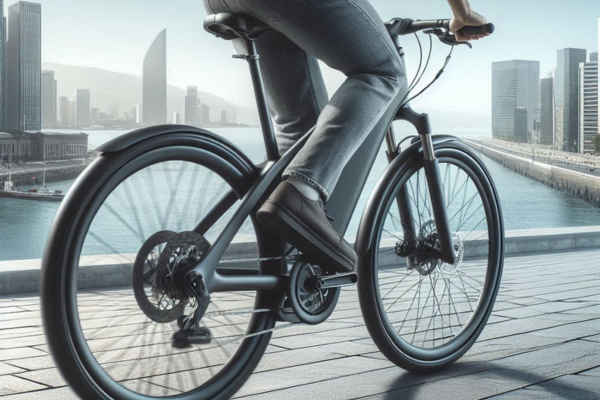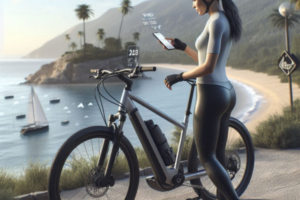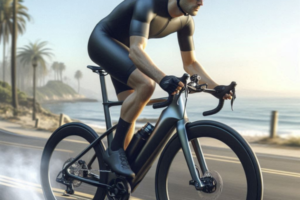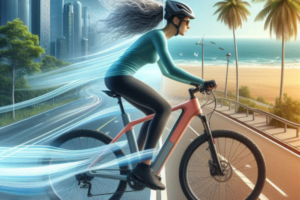💨 Why Tires Matter for Aerodynamics
When considering wind resistance on an electric bicycle, most riders focus on the frame, riding posture, or accessories. But one of the most overlooked components in aerodynamic performance is the tire. The width, tread pattern, and even the shape of a tire can influence how air flows around the bike — and ultimately, how efficiently it rides.
🔄 Rolling Resistance vs. Air Resistance
🔧 Understanding Rolling Resistance
Rolling resistance is the energy required to keep the tire moving over a surface. It’s affected by rubber compound, tire pressure, and tread deformation. Lower rolling resistance improves battery efficiency and reduces rider effort.
🌬️ Understanding Air Resistance
Air resistance, or aerodynamic drag, is the force opposing the tire’s forward motion due to air friction. It increases with speed and becomes significant above 20 km/h — a typical cruising speed for many e-bikes.
🚴♀️ Tire Width and Wind Resistance
📏 Wider vs. Narrower Tires
Wider tires offer more grip and comfort but increase the bike’s frontal area, leading to higher drag. Narrower tires, while less cushioned, cut through the air more efficiently and reduce wind resistance.
🛣️ Suggested Widths by Use
- 35 mm and above: Ideal for comfort and grip, but more aerodynamic drag
- 28–32 mm: Balanced option for urban commuting and mild terrain
- 25 mm or less: Designed for speed and maximum aerodynamic performance on smooth roads
🧪 Tread Pattern and Airflow Disruption
🌊 The Effect of Tread Design
Slick tires provide the cleanest airflow, minimizing turbulence and reducing drag. On the other hand, aggressive or knobby tread patterns create micro-vortices that disturb airflow and increase resistance.
💡 Choosing the Right Pattern
For paved roads and higher-speed commutes, semi-slick or slick tires offer the best aerodynamic benefit while still maintaining road grip — even in humid or coastal environments.
⚙️ Tire Pressure and Shape
📉 Underinflation vs. Overinflation
Underinflated tires flatten against the road, increasing drag and reducing efficiency. Overinflated tires may reduce comfort and traction but slightly improve rolling performance. Finding the balance is essential.
🛠️ Best Practices for Pressure
- Use a reliable pressure gauge for accuracy
- Follow manufacturer guidelines for pressure range
- Adjust based on load, weather, and terrain
🌬️ Airflow and Rotational Effects
🔄 Rotating Tires and Turbulence
As the wheels spin, they disturb surrounding air. Tires with smooth sidewalls and rounded profiles generate less turbulence and maintain better airflow across the lower part of the bicycle.
🔧 How to Reduce Turbulence
- Keep tires clean and free of debris
- Pair with aerodynamic wheel rims when possible
- Opt for tires with minimal sidewall branding or texture
🛠️ Choosing Tires for Wind Efficiency in Humid Environments
🌫️ What to Look for
In coastal or humid conditions, tires need both aerodynamic performance and strong wet-road grip. Consider:
- Semi-slick tread with water dispersion channels
- Durable rubber compounds that resist weathering
- Reinforced sidewalls for moisture protection
🛒 High-Performance Tire Features
Some high-performance tires are specifically designed for road efficiency and humid conditions. These typically feature:
- Streamlined, slick profiles to reduce drag
- Low rolling resistance rubber compounds
- Enhanced traction for wet or variable surfaces
🧠 Final Thoughts: Small Changes, Big Impact
Tires might seem like a minor detail, but their aerodynamic contribution is significant — especially at higher speeds or in windy environments. Choosing the right width, tread pattern, and pressure strategy will help you improve range, stability, and overall ride quality on your electric bicycle.
Have you noticed how tire choice affects your e-bike performance? Share your insights in the comments!



